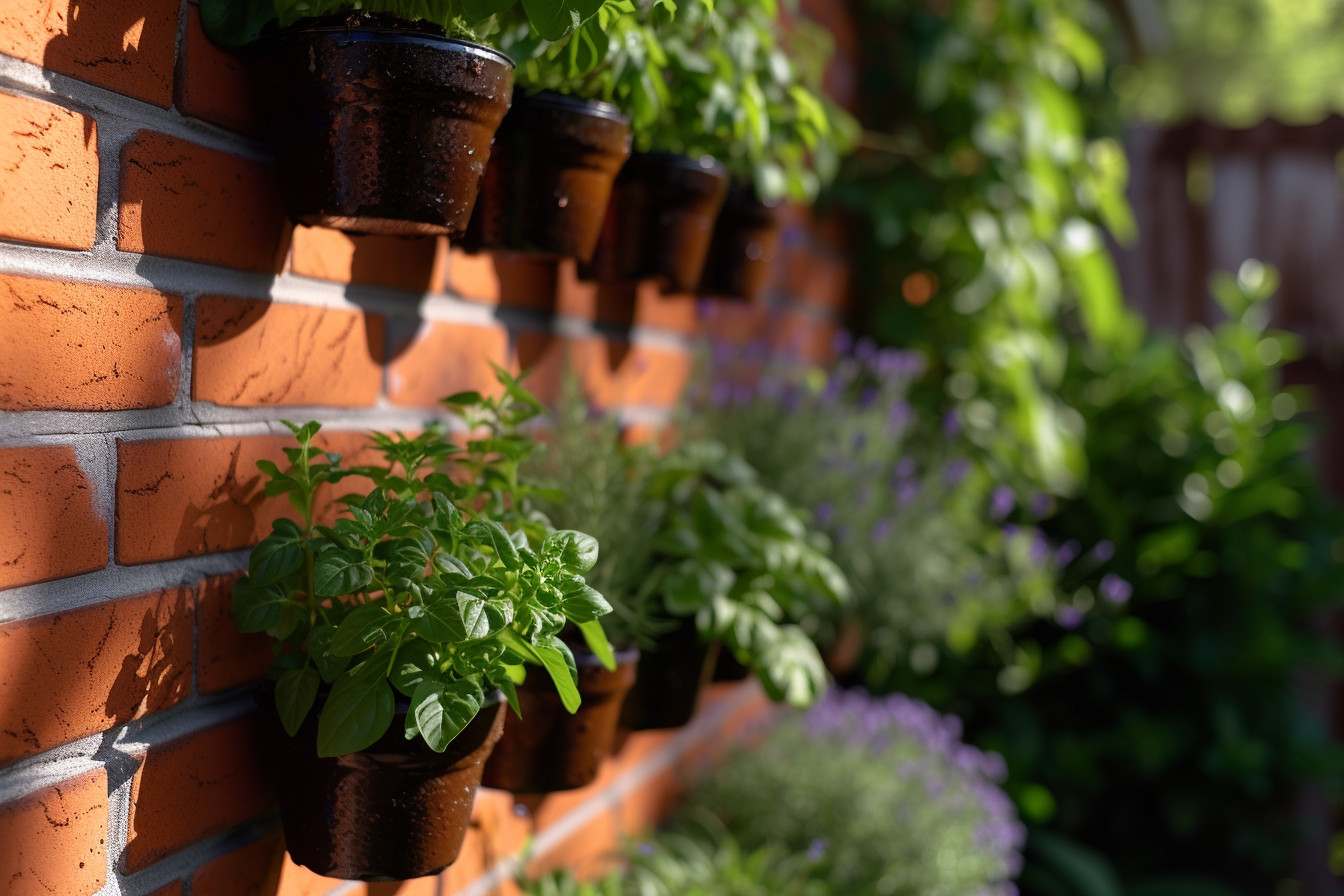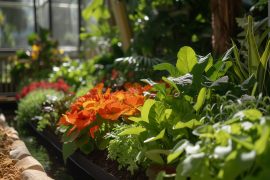Ever since I dove into the world of gardening, there’s always been something magical about nurturing life from a tiny seed. It might sound cliché, but hear me out—connecting with nature in such an intimate way brings peace to my often chaotic days. Now, let’s talk about vertical herb gardens specifically. These aren’t just practical for those short on space; they’re canvases where green thumbs can paint their masterpieces vertically.
So why go vertical? Simply put, it makes sense when you’re tight on space or if you want to add that lush aesthetic to your balcony, kitchen window, or even indoors under grow lights. And honestly, herbs are perfect for this setup. They thrive beautifully and require minimal fuss as long as they get plenty of sunlight, water, and a bit of love now and then.
Here comes the fun part: choosing what to plant as my personal favorites. Basil, mint, and parsley—these aromatic plants not only elevate any dish but also grow them, which is utterly rewarding. The scent wafting through the air, as I brush past my hanging pots, propels me straight into Zen mode. Oh, did I mention harvesting your own fresh supply right at your fingertips while being wholly sustainable? What more could I ask?
Benefits of Vertical Herb Gardens
Stepping into my garden, the tranquility and lush greenery instantly wash away the day’s stress. Among these peaceful residents are my vertical herb gardens—tall towers of aromatic bliss that not only serve as a feast for the eyes but also provide numerous benefits worth sharing.
Vertical gardening is like hitting two birds with one stone; it saves space while adding an aesthetic charm to any area. Especially in urban settings where ground space feels more like luxury real estate, going vertical lets people grow their herbs without needing a sprawling backyard. Imagine transforming a bare balcony or modest patio into your personal Eden! This approach allows us to maximize our growing potential vertically rather than horizontally, which is perfect for those who might think they lack room for gardening.
What’s fascinating about opting for this style isn’t just its spatial efficiency but how it becomes an interactive art piece loaded with textures and fragrances right at eye level. Each shelf offers a different sensory experience, from peppermint’s vibrant zing teasing your nose on one tier to basil’s sweet aroma calming you on another.
Beyond aesthetics, there’s undeniable educational value here too. Newcomers get hands-on lessons in plant care since managing light exposure, watering routines, and nutrient distribution across multiple levels requires attentive adjustment. It turns out that messing around with dirt can teach us quite a bit.
a bit!
Here are some fun numbers that’ll give you food (or, should I say, ‘herb’*) fo thought:
| Benefit | Impact |
|---|---|
| “Space-saving” | Utilizes up to 70% less land compared to traditional methods. |
Choosing the Right Location for Your Vertical Herb Garden
Finding that perfect spot to set up your vertical herb garden can feel a bit like being Goldilocks in search of the right porridge. It’s all about balance, and, truth be told, there are some key considerations you’ll want to keep in mind before you get those hands dirty. Let’s dive into what makes a location “just right” for your leafy friends.
Light is everything—or pretty close to it when we’re talking plants. Most herbs bask in full sunlight; they love soaking up those rays almost as much as I do on a beach day! We’re aiming for around 6–8 hours of direct light daily. This could mean situating your garden near south-facing windows if indoors—imagine having fresh basil within arm’s reach from the kitchen counter! Or finding clear spots without building shadows if outdoors.
But then again, too much sun? Not such good news either, especially during scorchers, where leaves might end up crisper than lush greenery would prefer. Moderation and protection come in handy here—think partial shading devices or strategic timing, so early morning sin does most illumination, avoiding peak heat times!
Air circulation plays its part quietly yet significantly prolongs plant health by deterring pesky diseases common with stagnancy damp environments. Think relatable moments stuck in humid, poorly ventilated rooms but applied to the plant world now picture an airy, light-filled space allowing whispers of breeze through keeping moisture levels check pests bay. Sounds ideal, doesn’t it?
And let us not forget accessibility and convenience. Who’d thought watering cycling woes would become a thing of the past? Whenever choosing locations, consider practicality in feeding and tending needs because there is no point placing our thriving bundles of joy in hard-to-reach places that are less likely to tend to care. Hence, choosing cleverly strategically, nurturing becomes a seamless second nature rather than a chore.
Finally, water source proximity cannot be overstressed. Imagine needing to lug heavy buckets every couple of days. This certainly adds to an unwanted workout routine. Ideally, a hose reel setup near a reservoir solution makes life easier, ensuring a verdant happy oasis flourishes with minimal effort expended on behalf of
So yeah, choosing the right spot, something simple reflection connection gardening spaces offer connecting surrounding natural elements Consequently, planting vertically introduces layer depth dimension, making efficient use of limited areas while simultaneously creating vibrant living artwork and personal relaxation corners. Crafted wisely serves to witness a wonder growth cycle lifetime.
Selecting the Right Herbs for Your Vertical Garden
Venturing into the world of vertical herb gardens can be like discovering a new palette in your culinary studio. These lush, green walls are not just about saving space; they’re an exploration of flavors waiting to happen right at your fingertips. Yet before you dive headfirst, it’s crucial to pick herbs that’ll thrive in these upward confines and reward you with their aromatic bounty.
Let me guide you through choosing plants guaranteed to flourish vertically while nourishing both body and soul:
- Mint loves company but needs its own container, as this friendly fellow tends toward takeover tactics.
- Basil, summer’s darling, calls for lots of light and warmth, making it perfect near a window or where there is artificial lighting.
- For those less sunny spots, consider chives. They’re pretty resilient outdoors, so indoors under grow lights? Piece of cake!
Not all heroes wear capes; some come bearing scents! Imagine starting your day by brushing past rosemary, releasing stress-relieving aromas, or pinching fresh basil leaves directly into the pan—talk about from garden to table!
Choosing herbs isn’t rocket science, yet knowing what goes well together could help prevent future horticultural heartbreaks (we’ve all been there!). Certain combos not only get along great visually but also support each other’s growth cycles: basil thrives alongside chervil, whereas oregano enjoys sage’s tranquil company.
Reflect on why creating spaces where peace meets productivity matters now more than ever: Cultivating serenity amidst our daily hustle extends beyond mere aesthetics—it anchors us back to Earth quite literally, one plant at a time. With every seed planted, we stitch threads matching patience, perseverance, and creativity, drawing closer towards self-sufficiency. nurturance This synergy between human care and nature forms boundless opportunities for learning, sharing, teaching, and joy in gardening.
Designing and Building Your Vertical Herb Garden
Picture this: You’re sipping your morning coffee, surrounded by lush greenery cascading down your wall. Each leaf is a whisper, inviting you to connect with nature right in the heart of your home. This isn’t just any garden; it’s your vertical herb garden—where culinary dreams meet urban living.
Creating such an oasis begins with design—a thoughtful reflection on space meets function meets aesthetics. Whether you’ve got a tiny balcony or just a kitchen corner crying for attention, deciding how much room you can dedicate will shape everything that follows. Options abound! From repurposed shoe organizers to custom-built wooden frames brimming with pockets for each plant child,.
Now let’s talk plants, because they’re truly the stars of our show here.
- Sun-lovers like basil thrive when they soak up those golden rays.
- Shade-tolerant herbs like mint prefer to live away from direct sunlight.
Knowing these preferences is key, as it’ll influence where you set up shop (south-facing walls are gold) and which herby buddies get premium real estate in sunnier spots.
Diving into DIY construction might sound daunting, but believe me, armed with at least YouTube tutorials and some basic tools, you’re more than capable:
1 Select Materials: Opt for cedar or redwood if budget allows—they fend off rot naturally.
2: Plan drainage outlays boldly; wet roots spell disaster quicker than anything else does!
3: Hang securely and harvest regularly—the fruits (or leaves, rather?) of labor are best enjoyed fresh!
It’s amazing really how something so functional could offer solace too—for there’s undeniable magic sprinkled across calm mornings tending to baby sprouts reaching upwards fiercely claiming their spot under the sky—or basking quietly amidst aromatic tranquility during hushed twilight moments meant solely for brewing tea brewed from freshly plucked peppermint soothing beyond reason.
Tips for Growing and Maintaining Vertical Herb Gardens
Let me tell you, there’s something almost magical about tending to a vertical herb garden. It’s not just the convenience of having fresh herbs right at your fingertips but also that connection with nature that turns even a small balcony or kitchen wall into a soothing green space.
Choosing the right spot can make all the difference when setting up your vertical garden. Herbs love sunlight; most need around 6 hours of direct light daily to thrive. So, if you’ve got a window facing south or west, you’re golden! But don’t worry too much if natural light is in short supply at yours; many indoor grow lights work wonders these days.
Watering is where things get kind of interesting with vertical gardens since gravity wants to play its part—water flows down naturally, which means plants on top might get more hydration than those below unless managed correctly. My tip? Check each plant individually rather than giving them all one long shower. And while overwatering can spell disaster (nobody likes soggy roots), certain self-watering setups really take out some guesswork by ensuring consistent moisture levels, perfect for those often away from home.
Now let’s talk soil, because yes, it DOES matter big time here: Loose and well-draining mixtures are what we’re aiming for, folks! This kind means oxygen finds its way easier among roots, keeping them happy campers indeed while preventing diseases caused by the lack of breathability found in compacted soils.
Don’t overlook regular maintenance either; harvesting promotes growth, making this practice mutually beneficial besides obviously enjoying their aromatic flavors. Your cooking will thank you later. Plus, picking leaves stimulates new ones sprouting, which basically encourages bushier
Plants
- Rotate periodically shield against potential pests lurking nearby, eager to snack on precious greens. Evading trouble simply attentively checking the usual suspects aphids, and spider mites, and through close inspection under leaf surfaces along stems, any signs of discomfort, mildew, or droopiness, act promptly, conclusions sort When doubt, pull old friend neem oil, an effective yet gentle remedy for bad guys while sparing good ensures peace of mind.
There ya have peeps—a little guide tucked introduces maintaining your own vert paradise, remembering foundation solid forecasting lush, vibrant yields ahead. Now excuse me, I’ve got basil pinch dinner tonight.
Harvesting and Using Herbs from Your Vertical Garden
Harvesting time in your vertical garden is like unraveling a treasure trove of flavors, ready to transform your culinary creations. Knowing the right moment to pick each herb ensures you capture its peak essence. For most herbs, this magical phase occurs just before they flower, when their leaves are packed with aromatic oils.
Here’s my go-to guide for harvesting:
- Basil: Once it reaches 6 inches tall, start picking those luscious leaves, but don’t let it bloom.
- Mint will practically beg you to harvest; taking some regularly actually promotes growth.
- Parsley? Cut the outer leaves at the base, which encourages more inner leaf production.
Navigating through these choices feels almost meditative, as I find myself instinctively knowing when an herb beckons. Trust me, there’s something profoundly satisfying about plucking fresh thyme sprigs using nothing but touch and scent under twilight skies.
Next comes storing or using these fragrant masterpieces straight away—drying them remains a favored tactic among enthusiasts aiming for year-round use.
- Hang bundles upside-down in well-aired spaces.
- Or opt for quicker methods: oven dry on low heat (never microwave!)
Yet, why wait? Infuse olive oil with rosemary branches tonight, or jazz up that salad dressing by going big on mint freshness—it instantly turns ordinary meals extraordinary! Picture layering pesto sauces where basil plays lead, supported by parsley undertones, while sage whispers subtly throughout… Yeah, seriously, drooling here!
Final Thought
So far, we’ve journeyed through every inch and corner of creating a vertical herb garden—and what a ride it’s been! Not only did we dive into setting one up, but we also explored all those nurturing steps to make sure our green buddies thrive.
Wrapping things up doesn’t mean our gardening escapades end here. Nope, it’s quite the opposite, actually. Think about this as more of an ongoing conversation between us fellow plant enthusiasts where I get to share bits and pieces that have sprouted from my own experiences.
- Reflecting on Connection: There’s something undeniably peaceful about tending to your plants and watching them grow under your care—like each watering session or pruning act brings us closer not just to nature but also quiets down that perpetual hustle inside our heads.
- Sharing Knowledge Keeps Us Growing: Just like how plants need sunlight, water, and love, the knowledge around cultivating them thrives on sharing too! The tips covered today are meant for everyone, whether you’re just starting out or already have soil-stained hands from years in the dirt.
Ever since I dove into the world of gardening, there’s always been something magical about nurturing life from a tiny seed. It might sound cliché, but hear me out—connecting with nature in such an intimate way brings peace to my often chaotic days. Now, let’s talk about vertical herb gardens specifically. These aren’t just practical for those short on space; they’re canvases where green thumbs can paint their masterpieces vertically.
So why go vertical? Simply put, it makes sense when you’re tight on space or if you want to add that lush aesthetic to your balcony, kitchen window, or even indoors under grow lights. And honestly, herbs are perfect for this setup. They thrive beautifully and require minimal fuss as long as they get plenty of sunlight, water, and a bit of love now and then.
Here comes the fun part: choosing what to plant as my personal favorites. Basil, mint, and parsley—these aromatic plants not only elevate any dish but also grow them, which is utterly rewarding. The scent wafting through the air, as I brush past my hanging pots, propels me straight into Zen mode. Oh, did I mention harvesting your own fresh supply right at your fingertips while being wholly sustainable? What more could I ask?
Benefits of Vertical Herb Gardens
Stepping into my garden, the tranquility and lush greenery instantly wash away the day’s stress. Among these peaceful residents are my vertical herb gardens—tall towers of aromatic bliss that not only serve as a feast for the eyes but also provide numerous benefits worth sharing.
Vertical gardening is like hitting two birds with one stone; it saves space while adding an aesthetic charm to any area. Especially in urban settings where ground space feels more like luxury real estate, going vertical lets people grow their herbs without needing a sprawling backyard. Imagine transforming a bare balcony or modest patio into your personal Eden! This approach allows us to maximize our growing potential vertically rather than horizontally, which is perfect for those who might think they lack room for gardening.
What’s fascinating about opting for this style isn’t just its spatial efficiency but how it becomes an interactive art piece loaded with textures and fragrances right at eye level. Each shelf offers a different sensory experience, from peppermint’s vibrant zing teasing your nose on one tier to basil’s sweet aroma calming you on another.
Beyond aesthetics, there’s undeniable educational value here too. Newcomers get hands-on lessons in plant care since managing light exposure, watering routines, and nutrient distribution across multiple levels requires attentive adjustment. It turns out that messing around with dirt can teach us quite a bit.
a bit!
Here are some fun numbers that’ll give you food (or, should I say, ‘herb’*) fo thought:
| Benefit | Impact |
|---|---|
| “Space-saving” | Utilizes up to 70% less land compared to traditional methods. |
Choosing the Right Location for Your Vertical Herb Garden
Finding that perfect spot to set up your vertical herb garden can feel a bit like being Goldilocks in search of the right porridge. It’s all about balance, and, truth be told, there are some key considerations you’ll want to keep in mind before you get those hands dirty. Let’s dive into what makes a location “just right” for your leafy friends.
Light is everything—or pretty close to it when we’re talking plants. Most herbs bask in full sunlight; they love soaking up those rays almost as much as I do on a beach day! We’re aiming for around 6–8 hours of direct light daily. This could mean situating your garden near south-facing windows if indoors—imagine having fresh basil within arm’s reach from the kitchen counter! Or finding clear spots without building shadows if outdoors.
But then again, too much sun? Not such good news either, especially during scorchers, where leaves might end up crisper than lush greenery would prefer. Moderation and protection come in handy here—think partial shading devices or strategic timing, so early morning sin does most illumination, avoiding peak heat times!
Air circulation plays its part quietly yet significantly prolongs plant health by deterring pesky diseases common with stagnancy damp environments. Think relatable moments stuck in humid, poorly ventilated rooms but applied to the plant world now picture an airy, light-filled space allowing whispers of breeze through keeping moisture levels check pests bay. Sounds ideal, doesn’t it?
And let us not forget accessibility and convenience. Who’d thought watering cycling woes would become a thing of the past? Whenever choosing locations, consider practicality in feeding and tending needs because there is no point placing our thriving bundles of joy in hard-to-reach places that are less likely to tend to care. Hence, choosing cleverly strategically, nurturing becomes a seamless second nature rather than a chore.
Finally, water source proximity cannot be overstressed. Imagine needing to lug heavy buckets every couple of days. This certainly adds to an unwanted workout routine. Ideally, a hose reel setup near a reservoir solution makes life easier, ensuring a verdant happy oasis flourishes with minimal effort expended on behalf of
So yeah, choosing the right spot, something simple reflection connection gardening spaces offer connecting surrounding natural elements Consequently, planting vertically introduces layer depth dimension, making efficient use of limited areas while simultaneously creating vibrant living artwork and personal relaxation corners. Crafted wisely serves to witness a wonder growth cycle lifetime.
Selecting the Right Herbs for Your Vertical Garden
Venturing into the world of vertical herb gardens can be like discovering a new palette in your culinary studio. These lush, green walls are not just about saving space; they’re an exploration of flavors waiting to happen right at your fingertips. Yet before you dive headfirst, it’s crucial to pick herbs that’ll thrive in these upward confines and reward you with their aromatic bounty.
Let me guide you through choosing plants guaranteed to flourish vertically while nourishing both body and soul:
- Mint loves company but needs its own container, as this friendly fellow tends toward takeover tactics.
- Basil, summer’s darling, calls for lots of light and warmth, making it perfect near a window or where there is artificial lighting.
- For those less sunny spots, consider chives. They’re pretty resilient outdoors, so indoors under grow lights? Piece of cake!
Not all heroes wear capes; some come bearing scents! Imagine starting your day by brushing past rosemary, releasing stress-relieving aromas, or pinching fresh basil leaves directly into the pan—talk about from garden to table!
Choosing herbs isn’t rocket science, yet knowing what goes well together could help prevent future horticultural heartbreaks (we’ve all been there!). Certain combos not only get along great visually but also support each other’s growth cycles: basil thrives alongside chervil, whereas oregano enjoys sage’s tranquil company.
Reflect on why creating spaces where peace meets productivity matters now more than ever: Cultivating serenity amidst our daily hustle extends beyond mere aesthetics—it anchors us back to Earth quite literally, one plant at a time. With every seed planted, we stitch threads matching patience, perseverance, and creativity, drawing closer towards self-sufficiency. nurturance This synergy between human care and nature forms boundless opportunities for learning, sharing, teaching, and joy in gardening.
Designing and Building Your Vertical Herb Garden
Picture this: You’re sipping your morning coffee, surrounded by lush greenery cascading down your wall. Each leaf is a whisper, inviting you to connect with nature right in the heart of your home. This isn’t just any garden; it’s your vertical herb garden—where culinary dreams meet urban living.
Creating such an oasis begins with design—a thoughtful reflection on space meets function meets aesthetics. Whether you’ve got a tiny balcony or just a kitchen corner crying for attention, deciding how much room you can dedicate will shape everything that follows. Options abound! From repurposed shoe organizers to custom-built wooden frames brimming with pockets for each plant child,.
Now let’s talk plants, because they’re truly the stars of our show here.
- Sun-lovers like basil thrive when they soak up those golden rays.
- Shade-tolerant herbs like mint prefer to live away from direct sunlight.
Knowing these preferences is key, as it’ll influence where you set up shop (south-facing walls are gold) and which herby buddies get premium real estate in sunnier spots.
Diving into DIY construction might sound daunting, but believe me, armed with at least YouTube tutorials and some basic tools, you’re more than capable:
1 Select Materials: Opt for cedar or redwood if budget allows—they fend off rot naturally.
2: Plan drainage outlays boldly; wet roots spell disaster quicker than anything else does!
3: Hang securely and harvest regularly—the fruits (or leaves, rather?) of labor are best enjoyed fresh!
It’s amazing really how something so functional could offer solace too—for there’s undeniable magic sprinkled across calm mornings tending to baby sprouts reaching upwards fiercely claiming their spot under the sky—or basking quietly amidst aromatic tranquility during hushed twilight moments meant solely for brewing tea brewed from freshly plucked peppermint soothing beyond reason.
Tips for Growing and Maintaining Vertical Herb Gardens
Let me tell you, there’s something almost magical about tending to a vertical herb garden. It’s not just the convenience of having fresh herbs right at your fingertips but also that connection with nature that turns even a small balcony or kitchen wall into a soothing green space.
Choosing the right spot can make all the difference when setting up your vertical garden. Herbs love sunlight; most need around 6 hours of direct light daily to thrive. So, if you’ve got a window facing south or west, you’re golden! But don’t worry too much if natural light is in short supply at yours; many indoor grow lights work wonders these days.
Watering is where things get kind of interesting with vertical gardens since gravity wants to play its part—water flows down naturally, which means plants on top might get more hydration than those below unless managed correctly. My tip? Check each plant individually rather than giving them all one long shower. And while overwatering can spell disaster (nobody likes soggy roots), certain self-watering setups really take out some guesswork by ensuring consistent moisture levels, perfect for those often away from home.
Now let’s talk soil, because yes, it DOES matter big time here: Loose and well-draining mixtures are what we’re aiming for, folks! This kind means oxygen finds its way easier among roots, keeping them happy campers indeed while preventing diseases caused by the lack of breathability found in compacted soils.
Don’t overlook regular maintenance either; harvesting promotes growth, making this practice mutually beneficial besides obviously enjoying their aromatic flavors. Your cooking will thank you later. Plus, picking leaves stimulates new ones sprouting, which basically encourages bushier
Plants
- Rotate periodically shield against potential pests lurking nearby, eager to snack on precious greens. Evading trouble simply attentively checking the usual suspects aphids, and spider mites, and through close inspection under leaf surfaces along stems, any signs of discomfort, mildew, or droopiness, act promptly, conclusions sort When doubt, pull old friend neem oil, an effective yet gentle remedy for bad guys while sparing good ensures peace of mind.
There ya have peeps—a little guide tucked introduces maintaining your own vert paradise, remembering foundation solid forecasting lush, vibrant yields ahead. Now excuse me, I’ve got basil pinch dinner tonight.
Harvesting and Using Herbs from Your Vertical Garden
Harvesting time in your vertical garden is like unraveling a treasure trove of flavors, ready to transform your culinary creations. Knowing the right moment to pick each herb ensures you capture its peak essence. For most herbs, this magical phase occurs just before they flower, when their leaves are packed with aromatic oils.
Here’s my go-to guide for harvesting:
- Basil: Once it reaches 6 inches tall, start picking those luscious leaves, but don’t let it bloom.
- Mint will practically beg you to harvest; taking some regularly actually promotes growth.
- Parsley? Cut the outer leaves at the base, which encourages more inner leaf production.
Navigating through these choices feels almost meditative, as I find myself instinctively knowing when an herb beckons. Trust me, there’s something profoundly satisfying about plucking fresh thyme sprigs using nothing but touch and scent under twilight skies.
Next comes storing or using these fragrant masterpieces straight away—drying them remains a favored tactic among enthusiasts aiming for year-round use.
- Hang bundles upside-down in well-aired spaces.
- Or opt for quicker methods: oven dry on low heat (never microwave!)
Yet, why wait? Infuse olive oil with rosemary branches tonight, or jazz up that salad dressing by going big on mint freshness—it instantly turns ordinary meals extraordinary! Picture layering pesto sauces where basil plays lead, supported by parsley undertones, while sage whispers subtly throughout… Yeah, seriously, drooling here!
Final Thought
So far, we’ve journeyed through every inch and corner of creating a vertical herb garden—and what a ride it’s been! Not only did we dive into setting one up, but we also explored all those nurturing steps to make sure our green buddies thrive.
Wrapping things up doesn’t mean our gardening escapades end here. Nope, it’s quite the opposite, actually. Think about this as more of an ongoing conversation between us fellow plant enthusiasts where I get to share bits and pieces that have sprouted from my own experiences.
- Reflecting on Connection: There’s something undeniably peaceful about tending to your plants and watching them grow under your care—like each watering session or pruning act brings us closer not just to nature but also quiets down that perpetual hustle inside our heads.
- Sharing Knowledge Keeps Us Growing: Just like how plants need sunlight, water, and love, the knowledge around cultivating them thrives on sharing too! The tips covered today are meant for everyone, whether you’re just starting out or already have soil-stained hands from years in the dirt.







